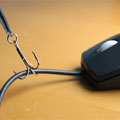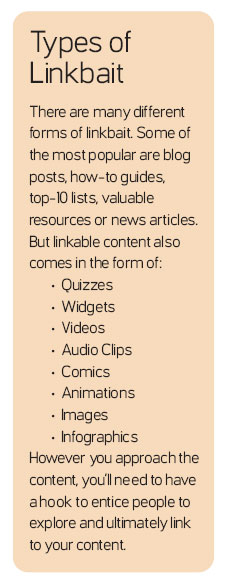The Anatomy of Linkbait

The Elements of Social Content Success
By Jordan Kasteler  Linkbait refers to any piece of content created to attract links by its sheer quality, usefulness or entertaining value. But perhaps on name alone or its relation to SEO, the practice often carries a negative connotation.
Linkbait refers to any piece of content created to attract links by its sheer quality, usefulness or entertaining value. But perhaps on name alone or its relation to SEO, the practice often carries a negative connotation.
While linkbait does bring tremendous SEO benefits from links and traffic, visitors also benefit from the quality content. As long as it's relevant to your audience and delivers on its promises, linkbait is really nothing more than carefully structured content that inspires action. But effective linkbaiting also requires strategy to get that content in front of those who will link to it. And one of the best methods of attracting links through content is through existing social media channels.
Seeding Linkbait
The best way to disseminate linkbait to the masses and capture links across the Web is to use social media to seed the content. Seeding refers to the act of submitting and posting your content to different social media communities, forums and directories. The purpose is to get the initial buzz stirring around the content and encourage people to share it with others.
The main seeding target for distribution is social news sites. Users submit content that others can vote on - if the community expresses a deep interest, the story is promoted to the front page for all to see, with an opportunity for users to click the story and be directed to the author's website. This can equate to thousands of people viewing and spreading your content by sharing it through the Internet. The most popular of these sites is Digg.com, but there are many more such as Reddit.com and Mixx.com, and even industry-specific sites like Sphinn.com.
These are not the only websites, however, to help content gain viral status. More publishers use sites like Facebook and Twitter to help spread their message to the masses. In all cases, linkbait first needs to be worthy - those linking to the content must perceive value and feel the content is worth attaching to their reputations.
Linkbait Hooks
A hook is a strategic approach to entice people not only to link to your content, but to click through and vote on it when promoting the link via social media or other means. Remember, the most valuable links do not come from the social media sites themselves. They come from journalists, bloggers and other publishers who were exposed to the content and, in-turn, write about it or republish it with a link back to the original source. These are also the same people who stay longer on your site, subscribe to feeds and provide additional page views.
People are more likely to believe, vote, and spread messages that reinforce their personal views. Tailoring content to those people is a surefire way to get more links and votes.
Essentially, the content should give people a way to feel important about themselves, someone they care about, or an issue they feel deserves attention. This can be done in numerous ways - being controversial, contrarian, spinning an opinion on recent events, or providing a resource.  Some hooks that draw people in the most are:
Some hooks that draw people in the most are:
News Hooks - Breaking a hot news story on your site will all but guarantee a large amount of traffic and keen interest from the social news communities. However, news hooks are not the most linkable. Once the story becomes old news, it's no longer a valuable resource to link to.
Contrary Hooks - Playing devil's advocate is a good way to get attention, traffic, and links. Contrary content must be created with great caution, however. Unpopular opinions can cause damage in the form of down votes on social sites and unsubscribes from your content.
Resource Hooks - Creating a great resource of links, tutorials, information, and more are some of the best ways to attract a large amount of links. The great thing about resources is they rarely go stale. You can always go back and update them, if needed.
Humor Hooks - Next to news, funny and offbeat content is one of the most popular to share. The advantage humor has over news is its great longevity.
Ego Hooks - Appealing to prominent community members' egos will entice them to help promote the content with their honorable mention. This can be done in the form of interviews, spotlights and lists. Ego-based content has a high success rate of obtaining links from those people featured in your content, as well as their entire personal and professional networks.
Link Attraction
When creating linkbait it's crucial to make it easy for users to identify and connect with the content.
People tend to appreciate content that appears comprehensive. Unfortunately, this is somewhat of a catch 22 - too lengthy and fluffy can bore social users and deter them from exploring the content in its entirety. Most writing is quite wasteful in nature so be prepared to trim off much of what you create. Make content easy to scan with bullet points, hierarchically ordered with headlines, and important highlights bolded. By creating ordered or bulleted lists, an incomplete story can look well researched.
In addition, content that links out to related resources and further reading makes your story look well researched and associates your work with other trusted names or brands in your field. But link judiciously - too many outgoing links distracts readers, causing them to leave and link to someone else.
Linkbait is not only judged by what it is but also how it appears. Cleaning up and decorating content using quality design and relevant images appeals to people's first impression of the site before they even read the content, establishing trust and credibility.
Social Media Success
It's hard to be critical of your own work. Therefore, getting others' feedback is important before launching linkbait. Ask about emotions the linkbait evokes and why they might or might not link to the content. Approach the material from every emotion and angle to gain a holistic view of what directions the social media communities might take it. This may allow you to pre-empt any negative repercussions.
Titles and Headlines
Be specific with headlines. Focus on writing something that elicits emotional responses rather than writing for keywords and SEO. Many social news sites do not require people to read the article to vote, so the title may be far more important than the actual content of your linkbait.
Timing
Social media sites are frequented most during business hours. The best time to submit content to these sites for maximum visibility varies but is almost always early morning around 8 a.m. PST.
Accounts
Content shared from active users tends to be trusted more than content shared by new or inactive users. Some social news sites have algorithms that give extra authority to active users who frequently submit and vote on popular content. When submitting linkbait, be sure it's through an active account.
Location
Submitting content to the right category is imperative for the content's success. A submission to the wrong category will aggravate users looking for related content to that category and thus cause them to take such actions as downvoting or reporting a negligent user.
Getting Results
It's important to know that linkbait is part of a long-term strategy. Not every piece will be a success and some will gain far more links than others. Therefore, it's imperative to set forth on a long-term strategy using several pieces of content each month. Then look at the total traffic and links overall at the end of the campaign instead of on a one-off basis. Over time, (and using analytics) you will learn the preferences of your target communities, both in the content they share and their methods of distribution. Fine-tuning your approach will result in more shared content, links and traffic.
About the Author: Jordan Kasteler is a co-founder of Search & Social, a social media marketing and search engine optimization firm. He can be reached at Jordan@searchandsocial.com.

Subscribe to Our Newsletter!
Latest in Marketing








